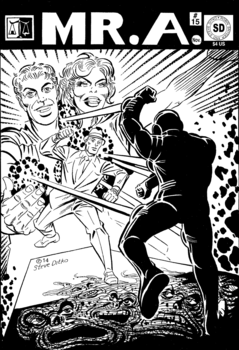Indy Internet Offerings Indicate Absolute Allusion to Old Time Artistry October 2, 2014
Comic art legend Steve Ditko is still going strong with his new 'Mister A #15', produced collaboratively with long time editor/publisher Robin Snyder. As writer/editor, Mr. Snyder had collaborated with Ditko in years past on numerous famous properties at the largest publishing companies in the field. In the late 1980s, they decided to take the independent route, eschewing the establishment and staying true to their personal and artistic principles. Their current issue is a testament to just this: thoughtful storyline driven by philosophic underpinnings. The notions of ethical compromise and rationalized hypocrisy are integral to the theme of this story, woven into a tale of newspaper reporting and mob influenced white collar crime. The mysterious Mr. A, having appearing in numerous publications over many years, uses a surrealistic calling card as a symbol of the breakdown between right and wrong by the encroaching gray area of moral ambivalence. This card is graphically presented as having black and white halves, transitioning with an organic growth of grey into a solid black toward those criminals to whom the card is presented: here the story briefly takes on the tone of the supernatural, and an editorial note promises the Origin of Mr. A in an upcoming magazine. Action fans as well as those seeking intellectual stimulus will be satisfied by Mr. A: the fight scenes are dramatically portrayed and integrated with the overall storyline as only a master of sequential organization can deliver - Ditko, whose cinematic layouts effortlessly lead the viewer through his realizations, uses his famed simplicity and contrast to design panels and pages capable of instructing even accomplished cartoonists. Little wonder this top creator has numerous Facebook fan organizations and blogs devoted to his continuing output and fellow professionals still marvel at his skill with ink brush technique. Recently, Snyder and Ditko have been utilizing the popular Kickstarter site to successfully fund these ventures and their next project is already in the pre-press production stage. One of the companies at which Snyder/Ditko worked was the variegated Charlton line, now defunct, but enjoying a renaissance as Charlton Neo under editors and long-time comics pros Roger McKenzie and Mort Todd, who are supporting the founder of this movement, the cryptic Fester Faceplant. Taking advantage not only of established characters and vintage stories which have fallen into the public domain, the team nevertheless emphasizes all new creations. Using the far-flung Charlton array of love stories to war drama, hot rod tales to western roundup, the resurrected 'Big C' imprint, brought to us by Comicfix, delivers all of this: a group of titles in which superheroes have a beloved and legitimate place, but where they do not dominate in a one dimensional and hyper-commercial appeal to adolescent power fantasies. Furthermore, this aggregation of talent can boast mini-posters and center-spreads by artists such as former Charlton art director Frank McLaughlin and current Dick Tracy newspaper artist Joe Staton. Charlton Arrow #2 features several types of stories, and a horror tale, 'The Cure-All', written by Stephen Skeates, is of particular delight. Ably illustrated by Howard Bender and Neil D. Vokes, the author uses Charlton Horror Host Mr. Bones to introduce and conclude the tale with a brief epilogue. This werewolf offering has a protagonist evoking sympathy from the reader, flashback and daydream sequences, and concludes with a very unexpected and fulfilling ending. Likely a student of O. Henry, the scribe's art team is rewarded with a center spread in the magazine, two pages in mini-poster style that highlight their caricature, delineation and coloring skills. Editorial notations indicate that Mr. Skeates, whose prior Aquaman stories are still the subject of fan praise, will return to Charlton Neo in the near future. Previously highlighted in this column, and worthy of another mention, is Jason Crawley's 'Bloke's Terrible Tomb of Terror'. In issue #10, Mike Hoffman displays his usual artistic brilliance, but the standout tale is illustrated by Nik Poliwko, the highly amusing 'Exterminate!', written by Crawley as a tribute to the E.C. Science Fiction stories of the 1950s. Poliwko is a versatile pencil/ink artist and is capable of working in a classic style; indeed, the influence of Wallace Wood is clear. The final page of the story not only is in the 'twist ending' type of E.C. tradition, but is a full sized splash panel emphasizing the artist's skill. This, for those familiar with early comic fandom, is a genuine 'Squa Tront' moment with a combination of the humorous and the horrific. Although it is regettable, now that comics enjoy more legitimacy than
ever before, that so much of what is available is unpalatable to those
familiar with a broader base of plot, story and art, at least the urge
to artistic integrity is unquenchable for some; established veterans
and newcomers alike are proving that comics will once again weather
the storm. |
Back to Examiner Articles | Next
Article
Back Home | Cartoon
History Links Page
